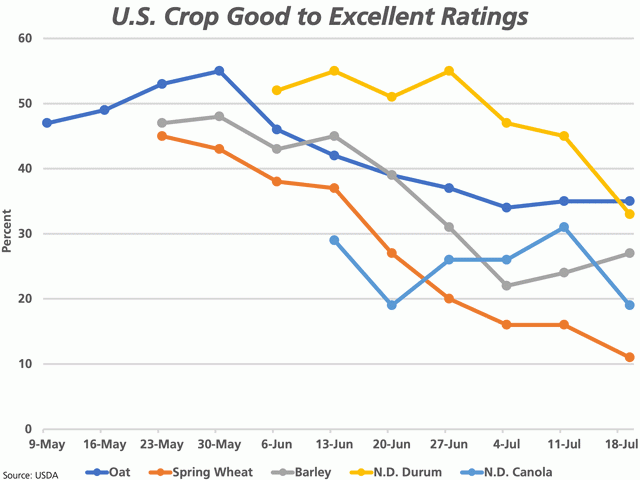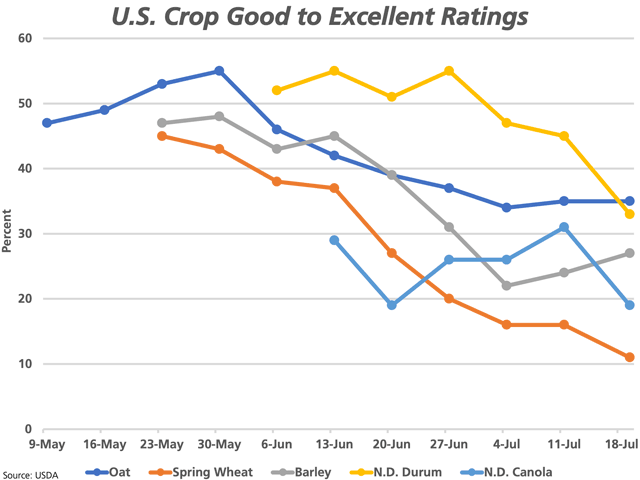Canada Markets
A Look at US Crop Condition Ratings
The continued decline in the estimated crop condition for several crops in the United States, largely due to conditions across the Northern Plains states and the Pacific North West, may be a preview of what the Prairies will face in the upcoming weeks and will surely influence the directional movement of grain during the upcoming crop year.
Sizeable volumes of U.S. corn have already traded into southern Alberta for the next crop year, while across all crops, sellers will be showing hesitation, given the uncertainty about the size of the crop, while buyers may be more eager than ever to cover their needs.
During the past week, the USDA's Crop Progress report shows the good-to-excellent crop condition rating for spring wheat falling by 5 percentage points, North Dakota durum falling by 12 percentage points and North Dakota canola falling by 12 percentage points from the previous week. The G/E rating for oats remained unchanged at 35% and the G/E rating for barley increased for a second week to 27 percentage points.
P[L1] D[0x0] M[300x250] OOP[F] ADUNIT[] T[]
Of the five crops shown, the spring wheat rating has fallen to the lowest level shown at 11% G/E, the lowest since 1988, while has fallen the most from its reported high this season by 75.6%. This rating has fallen in seven of the past eight weeks. While a snapshot in time, the July USDA WASDE report estimated U.S. hard red spring wheat imports at 70 mb (1.9 million metric tons) for 2021-22, up 49% from 2020-21 and would be the highest volume imported in four years. Meanwhile, the crop condition continues to be reported lower.
Another market to watch is the durum market. In the July World Agricultural Supply and Demand Estimates (WASDE), the USDA estimated U.S. production at 37 mb (1.007 mmt), with imports forecast at 60 mb (1.633 mmt). USDA data shows that 2021-22 imports of durum will surpass production for the first time in data going back to 1984-85 while this imbalance grows along with declining conditions.
Northern U.S. barley may feel the continued pull from the southern Alberta feed market in the crop year ahead, while malt quality in both countries will be pulled in all directions, with summer weather having the ability to push protein levels higher and tightening available supplies.
Canada's expected record-low carryout of oats from 2020-21 along with lower acres seeded in 2021 in both Canada and the U.S. has driven the December oat contract to a fresh contract high on July 20 at $4.45/bushel, reaching its highest trade seen since March 2014 or more than seven years. This month, the USDA estimated oat imports for 2021-22 at 92 mb or (1.419 mmt), up 7.6% from last year.
Cliff Jamieson can be reached at cliff.jamieson@dtn.com
Follow him on Twitter @Cliff Jamieson
(c) Copyright 2021 DTN, LLC. All rights reserved.






Comments
To comment, please Log In or Join our Community .